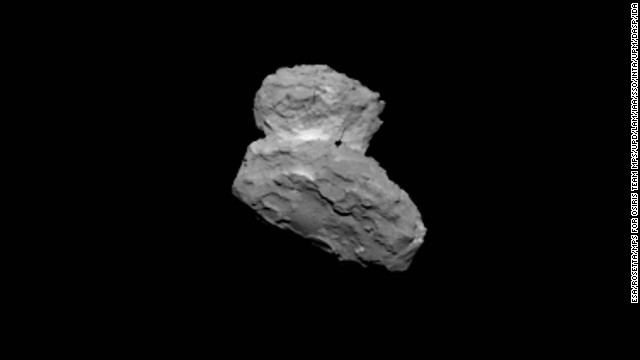Are we there yet? Rosetta closes in on comet close encounter
August 4, 2014 -- Updated 2036 GMT (0436 HKT)
Source: CNN
Pictures of the oddly-shaped rock have already been returned but on Wednesday scientists at the European Space Agency,
which is leading the project, say they hope to see images from within
about 75 miles as the probe carries out the last of its braking
maneuvers.
If successful, the
mission will notch up a series of firsts. Rosetta will be the first
spacecraft to orbit a comet on its journey around the sun, and in
November mission controllers aim to place the robotic lander Philae on
the surface -- something that has never been done before.
 Rosetta: The comet chaser
Rosetta: The comet chaser
Previous missions have
performed comet fly-bys but Rosetta is different. This probe will follow
the comet for more than a year, mapping and measuring how it changes as
it is blasted by the sun's energy.
Mission controllers had
to use the gravity of Earth and Mars to give the probe a slingshot
acceleration to meet its target on the right trajectory. Rosetta also
had to be put into hibernation for more than two years to conserve power
before being woken up successfully in January this year.
Scientists hope to learn
more about the composition of comets and perhaps whether they brought
water to the Earth or even the chemicals that make up the building
blocks of life.
It really is such a step forward to anything that has come before
Matt Taylor, Rosetta project scientist
Matt Taylor, Rosetta project scientist
"It really is such a step forward to anything that has come before," project scientist Matt Taylor told CNN.
Rosetta will soon begin
mapping the surface of Comet 67P/Churyumov-Gerasimenko and find out more
about its gravitational pull. This will help to find a suitable landing
site for Philae and allow engineers to keep Rosetta in the right orbit.
As comets approach the
sun, any ice melts and is turned into an ionized gas tail. The dust
produces a separate, curving tail. It's these processes that Rosetta
scientists hope to be able to study from close proximity.
Taylor explained that the survey will show the team what the comet nucleus looks like now and when it gets closer to the sun.
"We'll be able to make a
comparison to now, when its relatively inert, to when it's highly
active ... making this measurement over a year when we're riding
alongside at walking pace and observing how a comet works and interacts
with the sun," he said.
"We are there for over a
year to see this compete development to the extent that you may even be
able to measure the decrease in the volume of the nucleus ... see how
much material has left the comet."
Rosetta's target comet
67P/Churyumov-Gerasimenko is known as a short-period comet. It reappears
every six years as its orbit brings it close to the sun. Halley's comet
has a period of about 76 years and is not due to return close enough to
Earth to be visible until 2061. Others only return after thousands of
years.
Matt Taylor says it is
unlikely that you will be able to see comet 67P with the naked eye but
you can follow the progress of the mission on Rosetta's blog and find out more with CNN's interactive coverage.

No comments:
Post a Comment